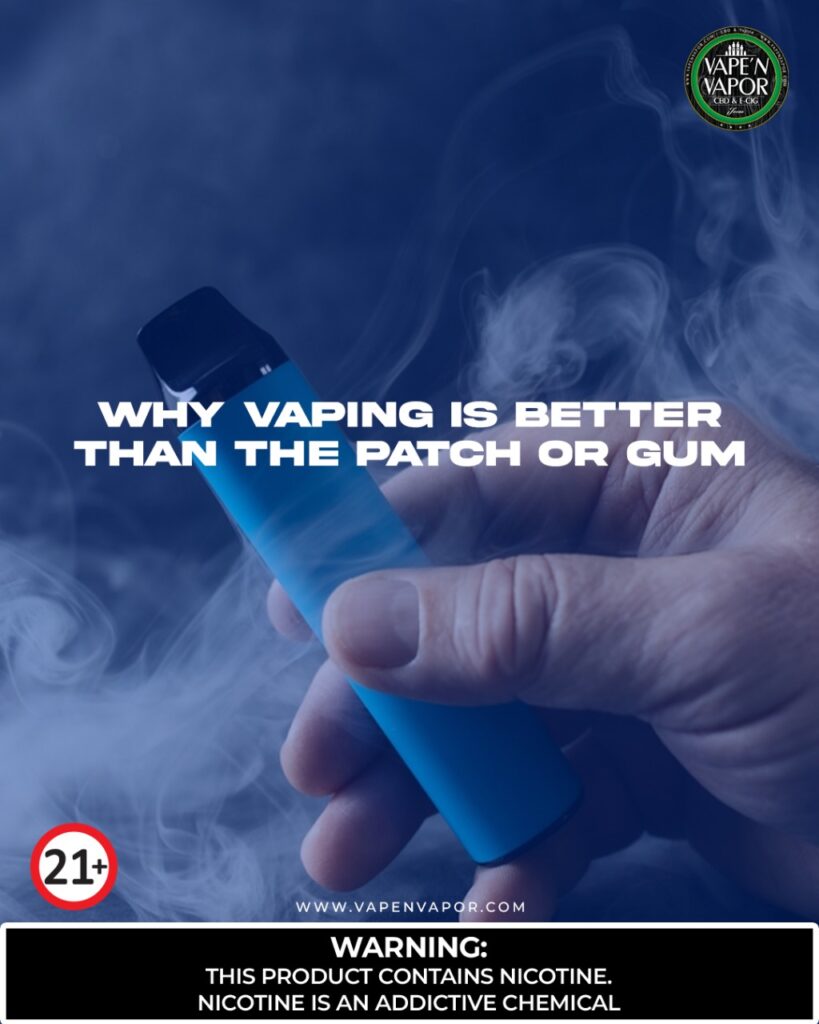No products in the cart.
Why Vaping Might Be a Better Option Than Nicotine Gum or Patches?

18 Apr
If you’ve ever tried a nicotine patch or gum, you are aware of how instantly it boosts your mood and energy levels. Nicotine is a stimulant that is widely known to be highly addictive. When we use patches or gum replacements, our ultimate goal is to help people quit smoking cigarettes, which is the whole purpose of these products.
As a trade – off, it does indeed work. You shouldn’t, however, use nicotine continuously. You need to have a small amount of nicotine on board to help you get through the brief process of attempting to wean yourself off of cigarettes gradually. It is not recommended that you use it for more than 3 months. If you continue using it after that point, a doctor’s supervision will be required. However, because nicotine is addictive, you will likely experience sadness, cravings, anxiety, sleep difficulties, and other negative effects if you try to stop using it.
There’s no denying the attraction of these drugs. Addiction to coffee and smoking are both caused by certain factors in human behavior. We live in a stimulant-dependent society. We are unable to guarantee that you will chew nicotine gum or that you will not like the experience. Since you could! Developing a new addiction while trying to overcome an existing one is not a logical course of action. You’re simply substituting one addiction for another.
The Nature of Nicotine
Tobacco contains nicotine, a stimulant that occurs naturally. It affects the human body in both stimulating and depressive ways. Its capacity to stimulate certain brain areas linked to mood regulation and cognition accounts for its addictive qualities. Nicotine replacement treatments, although highly addictive, work to reduce the symptoms of withdrawal by giving regulated quantities of nicotine without the toxins found in cigarettes.
Giving up smoking is a huge accomplishment. You should be happy that you are taking charge of your health! But let’s be honest — withdrawal from nicotine is a beast. Cravings, irritability, and difficulty focusing can make quitting seem like an uphill climb. Nicotine replacement therapy (NRT) can help with this. Low-dose nicotine products like gum, patches, and lozenges can lessen cravings and symptoms of withdrawal. Which choice is ideal for you, though, with so many to choose from?
Vaping has been a popular option for smokers trying to give up in recent years. Vaping has some potential benefits over more conventional NRT techniques like nicotine gum and patches, even if it is not without its drawbacks. To help you determine which nicotine gum, patches, or vaping is best for you and your smoke-free journey, let’s look into the advantages and disadvantages of each:
1.Nicotine Gum
One practical way for users to get their nicotine fix is by using nicotine gum, which is a common type of NRT. Nicotine is progressively produced and absorbed through the oral mucosa as the gum is chewed, relieving cravings. However, the effectiveness of nicotine gum varies based on the chewing habits of the individual, and side effects like nausea or vertigo may occur.
Here’s a quick rundown of the pros and cons:
- Pros:
- Gum delivers nicotine quicker than patches, offering near-immediate relief from cravings (think about 2mg nicotine gum equals how many cigarettes?).
- You can adjust your nicotine intake by chewing for a longer or shorter duration!
- Chewing gum is a more natural-looking habit compared to wearing a patch. It is easy to use.
- Cons:
- The amount of nicotine absorbed can vary depending on your chewing style. You might end up consuming more nicotine than intended.
- The nicotine wears off relatively quickly (usually within 30 minutes), leading to more frequent use. Hence, more addictive.
- Some people may find the constant chewing motion to be irritating.
2.Nicotine Patches
Nicotine patches provide a consistent, long-term delivery of nicotine through the skin. By lowering plasma nicotine levels consistently, this continuous delivery technique helps minimize cravings all day long. Although discrete and easy, patches have the potential to cause skin irritation at the application site for certain users, and the delayed start of effect may not immediately relieve cravings. It is worth noting that the effectiveness of these patches reduce with time. The more you use them, the less effective they get.
Here’s a quick rundown of the pros and cons:
- Pros:
-
- Patches provide consistent nicotine levels for 8-16 hours, reducing cravings over a longer period. Nicotine patches are very long lasting.
- Nicotine patches are very easy to use. All you need to do is apply, forget, and go about your day!
- Patches are worn discreetly under clothing, or you can just put them in your mouth (under the tongue, on the gum).
- Cons:
- It can take up to 30 minutes for the patch to start relieving cravings (compared to nicotine gum vs patch).
- You can’t adjust the nicotine dosage once the patch is applied.
- Some people experience skin irritation at the patch application site.
3.Vaping
Vaping has been more popular recently as a potential replacement for conventional NRT techniques. Vaping provides a similar nicotine effect to smoking but without the dangerous combustion byproducts by heating a liquid that contains nicotine, flavorings, and other ingredients. Users who vape can enjoy the delight of hand-to-mouth motion, unlike those who use patches or gum.
Here’s a quick rundown of the pros and cons:
- Pros:
- Vaping delivers nicotine quickly, similar to gum (think about 4 mg nicotine lozenge equals how many cigarettes).
- The act of inhaling and exhaling vapor can be a more satisfying replacement for smoking than gum or patches.
- Vapers can adjust nicotine strength and vapor production to personalize their experience.
- Cons:
- The long-term health effects are still under investigation.
- While generally considered less harmful than smoking, vaping can still be addictive due to the presence of nicotine.
- Vaping may be frowned upon in some social settings.
Vaping vs. Traditional NRT
Several research have compared vaping’s efficacy with more established NRT techniques, with encouraging findings. Vaping has shown higher efficacy in aiding smokers in quitting, both in short- and long-term trials. This is frequently accompanied by a decrease in coughing and phlegm production. Its attractiveness as a smoking cessation tool is further enhanced by the ability to personalize vaping devices and adjust nicotine dosage.
There are a lot of false beliefs around vaping. One myth is that vaping causes “popcorn lung,” which is an illness brought on by exposure to the chemical diacetyl, which is present in some e-liquids. But strict laws and testing procedures guarantee that e-liquids are examined carefully, reducing the possibility of dangerous chemicals like diacetyl. Moreover, research has not yet proven a conclusive connection between vaping and popcorn lungs.
Another myth is that there are no regulations on vaping, which raises questions about the safety of the products. In contrast, vaping goods follow legal requirements and go through rigorous quality inspections to guarantee customer safety. Regulatory agencies supervise the manufacturing and distribution of vapor goods, giving customers confidence in the dependability and quality of the items.
Furthermore, there’s a widespread misconception—especially among youth—that vaping acts as a springboard to smoking. Vaping experimentation is not always associated with regular tobacco smoking, despite evidence to the contrary. Research has refuted the idea that vaping is a gateway to tobacco usage, demonstrating that most young people who experience vaping do not go on to smoke.
Final Thoughts
Without a question, nicotine replacement treatments like patches and gum have assisted a lot of individuals in giving up smoking. With its instantaneous nicotine delivery and smoking-like feeling, vaping presents a strong substitute. The choice of smoking cessation strategy should, however, take into account medical concerns, lifestyle issues, and individual preferences. The ultimate objectives are still the same: quitting smoking and protecting one’s health.
The optimal NRT technique is determined by your unique requirements and preferences. Take into account elements such as your lifestyle, personal preferences, and the extent of your addiction. It is important to note that heavy smokers may find that vaping or chewing provide faster-acting relief. It would be wiser to use gum or patches if you require a discrete solution. Do you yearn for the tactile experience of smoking? Vaping might be a better fit.
Always keep in mind that becoming completely smoke – free is the ultimate objective! While some people may find that vaping has certain advantages over gum or patches, it’s vital to keep in mind that there are risks associated with using this method.
